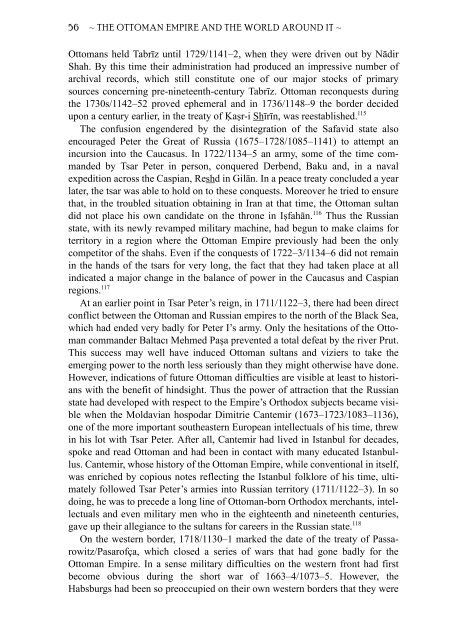The Ottoman Empire and the World Around It - Course Information
The Ottoman Empire and the World Around It - Course Information
The Ottoman Empire and the World Around It - Course Information
Create successful ePaper yourself
Turn your PDF publications into a flip-book with our unique Google optimized e-Paper software.
56 ~ THE OTTOMAN EMPIRE AND THE WORLD AROUND IT ~<br />
<strong>Ottoman</strong>s held Tabrīz until 1729/1141–2, when <strong>the</strong>y were driven out by Nādir<br />
Shah. By this time <strong>the</strong>ir administration had produced an impressive number of<br />
archival records, which still constitute one of our major stocks of primary<br />
sources concerning pre-nineteenth-century Tabrīz. <strong>Ottoman</strong> reconquests during<br />
<strong>the</strong> 1730s/1142–52 proved ephemeral <strong>and</strong> in 1736/1148–9 <strong>the</strong> border decided<br />
upon a century earlier, in <strong>the</strong> treaty of a r-i Shīrīn, was reestablished. 115<br />
K. s.<br />
<strong>The</strong> confusion engendered by <strong>the</strong> disintegration of <strong>the</strong> Safavid state also<br />
encouraged Peter <strong>the</strong> Great of Russia (1675–1728/1085–1141) to attempt an<br />
incursion into <strong>the</strong> Caucasus. In 1722/1134–5 an army, some of <strong>the</strong> time comm<strong>and</strong>ed<br />
by Tsar Peter in person, conquered Derbend, Baku <strong>and</strong>, in a naval<br />
expedition across <strong>the</strong> Caspian, Reshd in Gilān. In a peace treaty concluded a year<br />
later, <strong>the</strong> tsar was able to hold on to <strong>the</strong>se conquests. Moreover he tried to ensure<br />
that, in <strong>the</strong> troubled situation obtaining in Iran at that time, <strong>the</strong> <strong>Ottoman</strong> sultan<br />
did not place his own c<strong>and</strong>idate on <strong>the</strong> throne in I fahān. 116 s.<br />
Thus <strong>the</strong> Russian<br />
state, with its newly revamped military machine, had begun to make claims for<br />
territory in a region where <strong>the</strong> <strong>Ottoman</strong> <strong>Empire</strong> previously had been <strong>the</strong> only<br />
competitor of <strong>the</strong> shahs. Even if <strong>the</strong> conquests of 1722–3/1134–6 did not remain<br />
in <strong>the</strong> h<strong>and</strong>s of <strong>the</strong> tsars for very long, <strong>the</strong> fact that <strong>the</strong>y had taken place at all<br />
indicated a major change in <strong>the</strong> balance of power in <strong>the</strong> Caucasus <strong>and</strong> Caspian<br />
regions. 117<br />
At an earlier point in Tsar Peter’s reign, in 1711/1122–3, <strong>the</strong>re had been direct<br />
conflict between <strong>the</strong> <strong>Ottoman</strong> <strong>and</strong> Russian empires to <strong>the</strong> north of <strong>the</strong> Black Sea,<br />
which had ended very badly for Peter I’s army. Only <strong>the</strong> hesitations of <strong>the</strong> <strong>Ottoman</strong><br />
comm<strong>and</strong>er Baltacı Mehmed Paşa prevented a total defeat by <strong>the</strong> river Prut.<br />
This success may well have induced <strong>Ottoman</strong> sultans <strong>and</strong> viziers to take <strong>the</strong><br />
emerging power to <strong>the</strong> north less seriously than <strong>the</strong>y might o<strong>the</strong>rwise have done.<br />
However, indications of future <strong>Ottoman</strong> difficulties are visible at least to historians<br />
with <strong>the</strong> benefit of hindsight. Thus <strong>the</strong> power of attraction that <strong>the</strong> Russian<br />
state had developed with respect to <strong>the</strong> <strong>Empire</strong>’s Orthodox subjects became visible<br />
when <strong>the</strong> Moldavian hospodar Dimitrie Cantemir (1673–1723/1083–1136),<br />
one of <strong>the</strong> more important sou<strong>the</strong>astern European intellectuals of his time, threw<br />
in his lot with Tsar Peter. After all, Cantemir had lived in Istanbul for decades,<br />
spoke <strong>and</strong> read <strong>Ottoman</strong> <strong>and</strong> had been in contact with many educated Istanbullus.<br />
Cantemir, whose history of <strong>the</strong> <strong>Ottoman</strong> <strong>Empire</strong>, while conventional in itself,<br />
was enriched by copious notes reflecting <strong>the</strong> Istanbul folklore of his time, ultimately<br />
followed Tsar Peter’s armies into Russian territory (1711/1122–3). In so<br />
doing, he was to precede a long line of <strong>Ottoman</strong>-born Orthodox merchants, intellectuals<br />
<strong>and</strong> even military men who in <strong>the</strong> eighteenth <strong>and</strong> nineteenth centuries,<br />
gave up <strong>the</strong>ir allegiance to <strong>the</strong> sultans for careers in <strong>the</strong> Russian state. 118<br />
On <strong>the</strong> western border, 1718/1130–1 marked <strong>the</strong> date of <strong>the</strong> treaty of Passarowitz/Pasarofça,<br />
which closed a series of wars that had gone badly for <strong>the</strong><br />
<strong>Ottoman</strong> <strong>Empire</strong>. In a sense military difficulties on <strong>the</strong> western front had first<br />
become obvious during <strong>the</strong> short war of 1663–4/1073–5. However, <strong>the</strong><br />
Habsburgs had been so preoccupied on <strong>the</strong>ir own western borders that <strong>the</strong>y were


